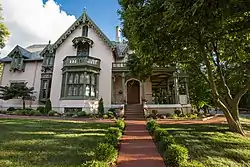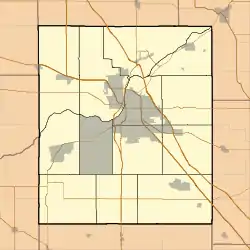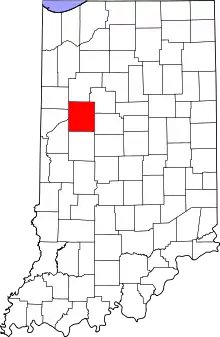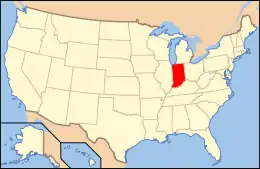Moses Fowler House
The Moses Fowler House is located at the corner of 10th and South streets in Lafayette, Indiana. The house is considered the finest example of a large Gothic Revival residence still standing in the United States. Upon his death in 1889, aged 74, Fowler had accumulated a fortune of an estimated three million dollars.[2] Fowler and his wife, Eliza (1817–1902),[2] were donors to various community interests, including Purdue University.
Moses Fowler House | |
 Front of the house in 2017 | |
   | |
| Location | Corner of 10th and South Sts., Lafayette, Indiana |
|---|---|
| Coordinates | 40°25′0″N 86°53′10″W |
| Area | less than one acre |
| Built | 1852 |
| Architectural style | Gothic Revival |
| NRHP reference No. | 71000009[1] |
| Added to NRHP | August 5, 1971 |
The house was built by Moses Fowler in 1851–1852. Locally harvested black walnut and white oak were used for the ornately carved woodwork. Italian immigrant craftsmen were brought via the Wabash and Erie Canal from New York City to execute the elaborate decorative plasterwork ceilings in the large north and south parlors. When completed it was one of the finest houses in Indiana. The designs for the house were principally taken from a copy of Andrew Jackson Downing’s book The Architecture of Country Houses, c. 1851, which Fowler purchased while on a business trip in New York City.[2]
Fowler originally came to Lafayette in 1839 from Circleville, Ohio,[2] with his friend and business partner John Purdue (founder of Purdue University) and engaged in the dry goods business. The business lasted until 1844, when the duo parted to pursue different goals.[2] Over the years a number of business pursuits made him very wealthy. These included the wholesale business, cattle ranching, the railroads, and banking.[2]
With his brother-in-law, Adams Earl (1819–1898),[3] Fowler founded a branch of the Indiana State Bank in about 1860. By 1865, with Earl having departed and with Fowler as its president, the local bank was merged into the National State Bank and grew steadily until its 20-year charter expired. In 1885, a new Fowler National Bank was organized with Moses Fowler the president.[2]

In 1861, Fowler founded the meat packing house of Culbertson, Blair and Co. in Chicago, Illinois. Around the same time, he and Earl began buying rich, level farmland in Benton County, Indiana.[2]
In the 1870s, Fowler donated over $40,000 and was involved in moving the Benton County seat from the town of Oxford, where a square still exists, to a new town platted in 1872 and called Fowler.[2]
Although separated from Eliza towards the end of his life, Moses left her a substantial amount of his fortune, which she shared philanthropically. She donated land for a new Presbyterian church, known since 1914 as Central Presbyterian, at 7th and Columbia streets. She also gave Purdue University $60,000 for the building and $10,000 for an organ and other equipment and furnishings in what would become Eliza Fowler Hall,[4] suitable for commencement ceremonies, lectures, and various other public programs.[2] She did not live to see Fowler Hall completed, but it was a Purdue campus landmark for half a century. Dedicated in 1903, it was demolished in 1954; but it reappeared, at least in name and memory, as the Eliza Fowler Hall section of the present Stewart Center complex at Purdue.[2]
Both Moses and Eliza are interred in Lafayette's Spring Vale Cemetery.[2]
In 1902, upon the death of his grandmother, Moses and Eliza's grandson, Cecil G. Fowler (son of James and Eva Fowler), inherited the house and he and his wife Louise made it their residence. Cecil had followed his father and grandfather into banking but was also a developer. He partnered with Carl Fischer (developer of the Indianapolis Motor Speedway) to build the first luxury hotel in Miami Beach, Florida, which opened on New Year's Eve 1920. In 1916–17, the Fowlers moved out of the house while significant renovations and additions were completed. During this time a large Tudor-style formal dining room and living room were added, along with an indoor kitchen, laundry, garage, and servants quarters. The upstairs now included seven bedrooms and five bathrooms. These included a new guest bedroom, master suite, and servants bedrooms. Outside, a large Italian-style tiered patio with fountains, a reflecting pool, a tea house, and formal gardens were added. The Fowlers loved to entertain and were well known locally for the large and extravagant parties they hosted. In 1940, with their children grown, the Fowlers sold the house to the Tippecanoe County Historical Association.
From 1940 until 2015, the Moses Fowler House was the home of the Tippecanoe County Historical Association and used at various times as a museum, offices, and for collections storage.
In 2015, The 1852 Foundation (a 501(c)(3) non-profit public charity) was founded through the generosity of Matt and Dr. Ann Jonkman.[5] The 1852 Foundation purchased the Fowler House Mansion and from 2015–2018 completed over $1.3 million in restorations, repairs, code updates, and facility additions in order that the house could be open to and used by the public for tours and as an events venue.
Gallery
References
- "National Register Information System". National Register of Historic Places. National Park Service. March 13, 2009.
- "Moses Fowler had far-reaching influence" - Journal & Courier, March 18, 2016
- Journal & Courier, 20 Jan 1980, p. 53
- "Indiana State Historic Architectural and Archaeological Research Database (SHAARD)" (Searchable database). Department of Natural Resources, Division of Historic Preservation and Archaeology. Retrieved 2016-07-01. Note: This includes Clark Dobbs and William Baugh (December 1970). "National Register of Historic Places Inventory Nomination Form: Moses Fowler House" (PDF). Retrieved 2016-07-01. and Accompanying photographs
- "Sold! Historic Moses Fowler House has new ownership". WLFI. June 11, 2015. Retrieved 23 December 2015.
Further reading
- Indiana Houses of the Nineteenth Century, Wilbur Peat, copyright 1962. pages 88.
- Historic American Buildings Survey in Indiana, edited by Thomas M. Slade, copyright 1983, page 122. ISBN 0-253-32741-5
External links
| Wikimedia Commons has media related to Moses Fowler House. |
- Tippecanoe County Historical Society
- www.fowlerhouse.org Fowler House official website
- Moses Fowler at Find A Grave
- Eliza Fowler at Find A Grave
- Cecil Gross Fowler at Find A Grave








